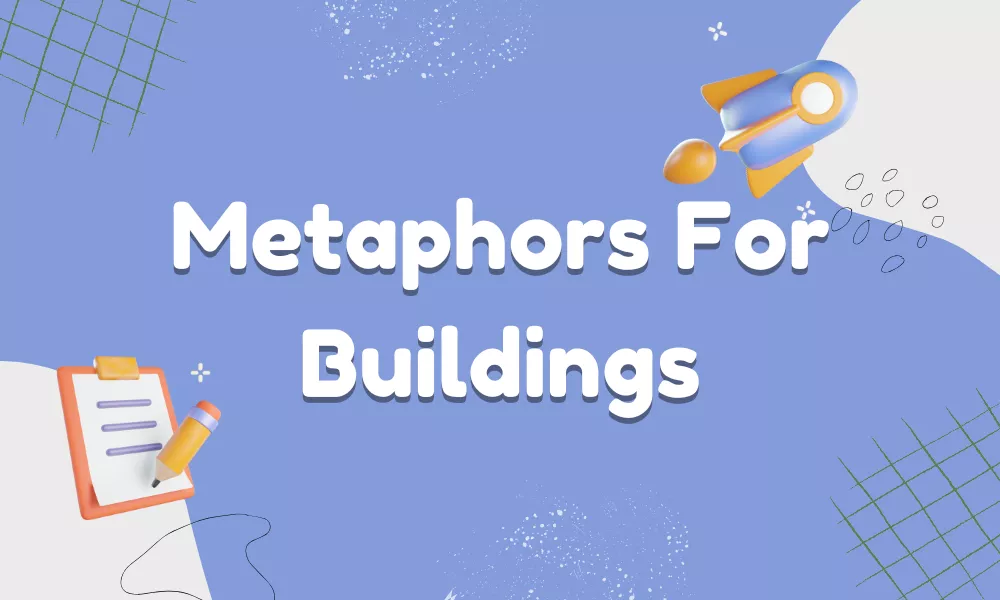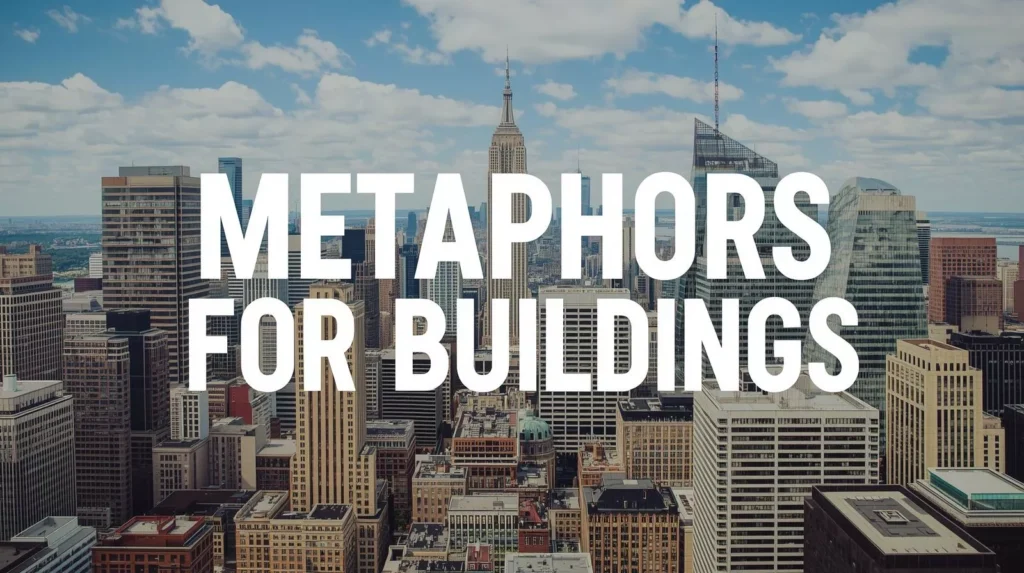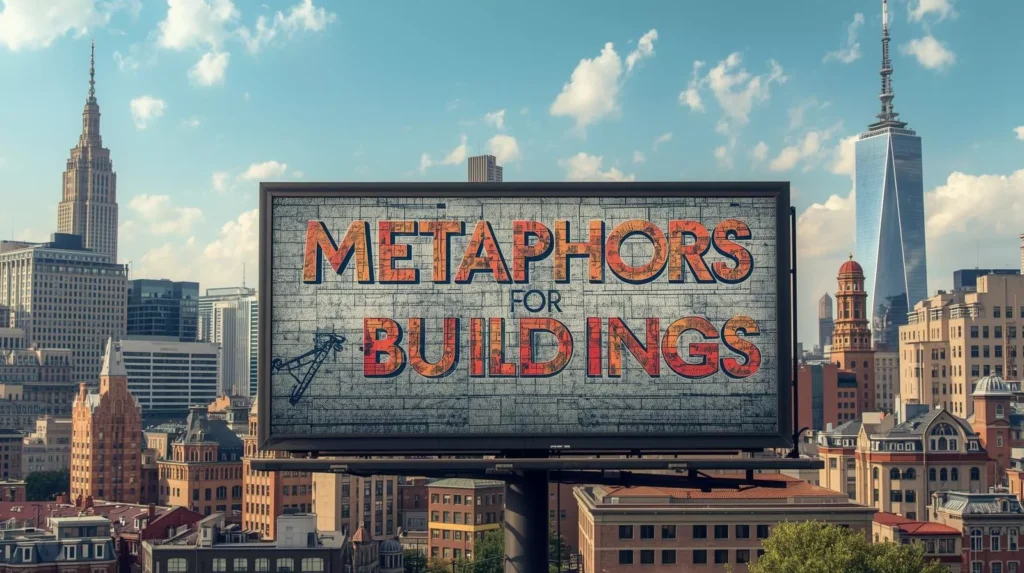Metaphors for Buildings – Symbolic Meanings and Examples

In the realm of language and imagination, buildings are more than just structures of brick, glass, and steel yet they are powerful symbols and living metaphors of human experience. Metaphors for buildings allow us to see architecture not merely as physical spaces but as reflections of our dreams, struggles, and achievements. A building can stand tall like a beacon of hope, shelter emotions like a home, or rise as a monument to human ambition. By comparing buildings to ideas, emotions, and stories, writers and speakers create vivid imagery that helps audiences connect abstract concepts with tangible realities.
What Are Metaphors for Buildings?
Metaphors for buildings are figurative expressions that compare structures to human ideas, emotions, or experiences to create deeper meaning and vivid imagery. Instead of viewing a building as just a physical space, these metaphors transform it into a symbol of reflection of strength, growth, community, or even vulnerability. For example, a skyscraper might be seen as a “ladder to the sky” representing ambition, while an old house could be described as a “keeper of memories.” Such metaphors help writers, speakers, and artists express complex ideas about life, progress, and identity through the language of architecture.

Everyday Metaphors for Buildings
- A Building is a Shelter of Dreams – Represents safety and aspirations.
Example: Her home was a shelter of dreams where hope never faded. - The House is a Heartbeat of the Family – Symbolizes emotional connection.
Example: That old house beats with every memory we’ve shared. - The Skyscraper is a Ladder to the Sky – Stands for ambition and progress.
Example: Each new floor built was another step up the ladder to the sky. - The Office is a Hive of Activity – Shows busyness and teamwork.
Example: The office was a hive of activity on Monday morning. - The Home is a Fortress – Represents protection and security.
Example: His home felt like a fortress against the chaos of the world. - The Apartment is a Box of Stories – Symbolizes diverse lives and experiences. Example: Every window in that apartment block hid a box of stories.
- The School is a Knowledge Factory – Shows production and learning.
Example: Our school is a knowledge factory shaping future minds. - The Church is a Beacon of Faith – Represents hope and guidance.
Example: The old church stood as a beacon of faith in the village. - The Library is a Treasure Chest of Wisdom – Symbolizes preserved knowledge. Example: The library was a treasure chest waiting to be opened.
- The Building is a Silent Witness – Suggests enduring presence.
Example: That old building stood as a silent witness to history. - The House is a Cradle of Comfort – Represents warmth and care.
Example: Her house was a cradle of comfort after a long day. - The Factory is a Giant Machine – Symbolizes production power.
Example: The factory worked like a giant machine without pause. - The Mall is a Modern Marketplace – Represents community and commerce.
Example: The mall was a modern marketplace filled with voices and colors. - The Building is a Guardian of Time – Reflects endurance.
Example: Centuries passed, yet the castle remained a guardian of time. - The Home is a Safe Harbor – Represents rest and security.
Example: After the storm, her home felt like a safe harbor. - The School is a Bridge to the Future – Symbolizes opportunity.
Example: Education is the bridge to the future built within school walls. - The House is a Mirror of the Soul – Represents identity.
Example: The way she decorated her home mirrored her inner self. - The Building is a Living Organism – Suggests adaptability.
Example: The building seemed to breathe with life as people filled its halls. - The City is a Concrete Jungle – Describes crowded urban life.
Example: He felt lost in the concrete jungle of New York. - The Roof is a Shield – Symbolizes protection.
Example: The roof stood like a shield against the rain. - The House is a Storybook – Represents memories.
Example: Every corner of that house told a story of their lives. - The Tower is a Giant Watchman – Suggests vigilance.
Example: The clock tower stood tall, a giant watchman over the town. - The Home is a Nest – Symbolizes warmth and family.
Example: Their home was a cozy nest for new beginnings. - The Building is a Skeleton of Steel – Highlights strength.
Example: The skyscraper’s frame rose like a skeleton of steel. - The Window is an Eye to the World – Represents perspective.
Example: She gazed through the window, the building’s eye to the world. - The Building is a Book of History – Symbolizes heritage.
Example: Every stone in that cathedral was a page in the book of history. - The Home is a Sanctuary – Represents peace and safety.
Example: Her home was her sanctuary after the chaos of the city. - The Wall is a Silent Protector – Symbolizes boundaries.
Example: The walls held firm, silent protectors of family life. - The Office is a Battle Arena – Represents struggle and competition.
Example: Each day in the office felt like entering a battle arena. - The City is a Beating Heart – Symbolizes energy and life.
Example: The city’s buildings pulsed like a beating heart at night. - The Bridge is a Thread of Connection – Represents unity.
Example: The bridge stitched the two sides of the town together. - The Castle is a Symbol of Power – Suggests authority.
Example: The castle stood high, a symbol of the king’s might. - The House is a Cage – Represents restriction.
Example: She felt trapped inside her house, a cage of routine. - The Church is a Lighthouse – Symbolizes moral guidance.
Example: The church served as a lighthouse for lost souls. - The Building is a Sleeping Giant – Suggests hidden strength.
Example: At dawn, the city’s skyline awoke like sleeping giants. - The Home is a Seed of Belonging – Represents roots and identity.
Example: Their small cottage was a seed of belonging in a foreign land. - The Tower is a Finger Pointing to Heaven – Symbolizes spirituality.
Example: The cathedral’s spire was a finger pointing to heaven. - The Building is a Cage of Glass – Represents transparency or fragility.
Example: The glass building looked like a shimmering cage. - The Door is a Gateway of Possibilities – Symbolizes new beginnings.
Example: Every door in life is a gateway to something new. - The Street is a River of Buildings – Depicts flow and connection.
Example: The avenue flowed like a river of buildings under the moonlight.
Cultural & Literary Metaphors for Buildings
- The Tower of Babel – Symbol of human pride and confusion.
Example: Their failed project became their Tower of Babel. - The House of Cards – Represents fragility or instability.
Example: His business was a house of cards ready to collapse. - The Ivory Tower – Symbolizes intellectual isolation.
Example: He lived in an ivory tower, detached from real life. - The Fortress of Solitude – Symbol of isolation and inner strength.
Example: His apartment became his own Fortress of Solitude. - The Glass Castle – Represents ambition mixed with vulnerability.
Example: She dreamed of building her own glass castle of success. - The Cathedral of the Mind – Symbolizes intellect and imagination.
Example: His ideas rose like arches in the cathedral of his mind. - The House of Memory – Represents nostalgia and remembrance.
Example: She wandered through the house of memory in her dreams. - The Palace of Dreams – Symbolizes aspiration and imagination.
Example: Every goal he achieved added another room to his palace of dreams. - The Bridge to Nowhere – Represents failed progress or false hope.
Example: Their promises turned out to be a bridge to nowhere. - The Broken Home – Symbolizes emotional loss or conflict.
Example: He carried the pain of growing up in a broken home.
Read: Metaphors for Birds
Creative & Modern Metaphors for Buildings
- The Skyscraper is a Digital Giant – Symbol of tech-driven ambition.
Example: The new tower stood tall, a digital giant in the skyline. - The Building is a Living App – Represents interactivity and innovation.
Example: Smart buildings today feel like living apps that respond to you. - The City is a Charging Port – Symbol of energy and modern life.
Example: The city is a charging port for dreamers and doers. - The Apartment is a Wi-Fi Nest – Represents connected yet isolated living.
Example: Each unit felt like a Wi-Fi nest, buzzing with virtual lives. - The Building is a Social Network – Symbolizes interconnected lives.
Example: That co-working hub is a social network built of steel and glass. - The Tower is a Data Stream – Represents flow of information.
Example: From the top floors, ideas streamed like data from a tower. - The Office is a Digital Hive – Symbol of tech-driven productivity.
Example: The open office buzzed like a digital hive of innovation. - The Mall is a Virtual Playground – Represents consumer connection.
Example: Modern malls feel like virtual playgrounds made real. - The Building is a Code of Concrete – Suggests modern engineering and design. Example: The architect’s new design was a code written in concrete.
- The City is a Living Circuit Board – Represents connectivity and modern progress.
Example: At night, the city glowed like a living circuit board.

Synonyms of Buildings
| Synonym | Meaning |
|---|---|
| Structure | A general term for anything constructed, often emphasizing form and stability. |
| Edifice | A large, impressive, or grand building. |
| Construction | Something that has been built or assembled. |
| Establishment | A building used for a particular purpose, often business-related. |
| Facility | A building designed for a specific function or service. |
| Premises | The land and buildings together, especially for business or property use. |
| Dwelling | A place where someone lives. |
| Complex | A group of related buildings serving one purpose. |
| Infrastructure | The foundational systems or buildings that support society. |
| Architecture | Both the art and physical form of constructed buildings. |
How to Use Buildings Metaphors in Writing & Speaking
- To Represent Personal Growth: Use building metaphors to illustrate how people develop over time.
Example: “She’s rebuilding her confidence brick by brick.” - To Describe Success and Failure: Compare achievements to constructing something strong and lasting.
Example: “He laid the foundation of his career with discipline and hard work.” - To Express Emotional States: Buildings can symbolize the heart or mind; stable or crumbling.
Example: “After the loss, his inner walls began to crack.” - To Convey Social or Cultural Ideas: Use metaphors to reflect how societies are structured or evolving.
Example: “Democracy is the framework that holds our nation together.” - To Inspire and Motivate: Building metaphors work powerfully in speeches or leadership contexts.
Example: “Let’s build bridges, not walls, between our communities.”
Read: Metaphors for Cars
Read: Metaphors for Roses
FAQs
Conclusion
Buildings are more than just walls and roofs, they are symbols of strength, growth, history, and human imagination. Through metaphors, we transform ordinary structures into meaningful representations of life, emotion, and progress. Whether it’s describing a “home as a sanctuary,” a “city as a living organism,” or a “skyscraper as ambition reaching the sky,” building metaphors help us see the world from new perspectives. In writing and speaking, these metaphors breathe life into descriptions, turning abstract ideas into vivid imagery that connects with readers and listeners on an emotional level.
